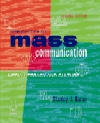Media industry researchers debate whether media effects are diminished when
audiences know that content is only make-believe and whether media reinforce
preexisting values or are replacing them. Social scientists test the explanations
of various theories advanced to answer these questions by doing research.
Quantitative research methods include experiments, surveys, and content analysis.
Experiments sacrifice generalizability for control and the demonstration of
causation. Surveys sacrifice casual explanations for generalizabilty and breadth.
Qualitative methods include historical, critical, and ethnographic research.
Researchers use methods such as the analysis of primary and secondary sources
and the undertaking of participant-observer studies. One of the most studied effects issue is the impact of mediated violence. Researchers
have studied the link between violent media content and subsequent aggressive
behavior, with social learning theory discrediting the notion of catharsis.
There is, however, disagreement regarding the exact interplay of content and
behavior. The impact of media portrayals of different groups of people and the
impact of the media on political campaigns are two other effects issues that
have been studied. | 


 2002 McGraw-Hill Higher Education
2002 McGraw-Hill Higher Education